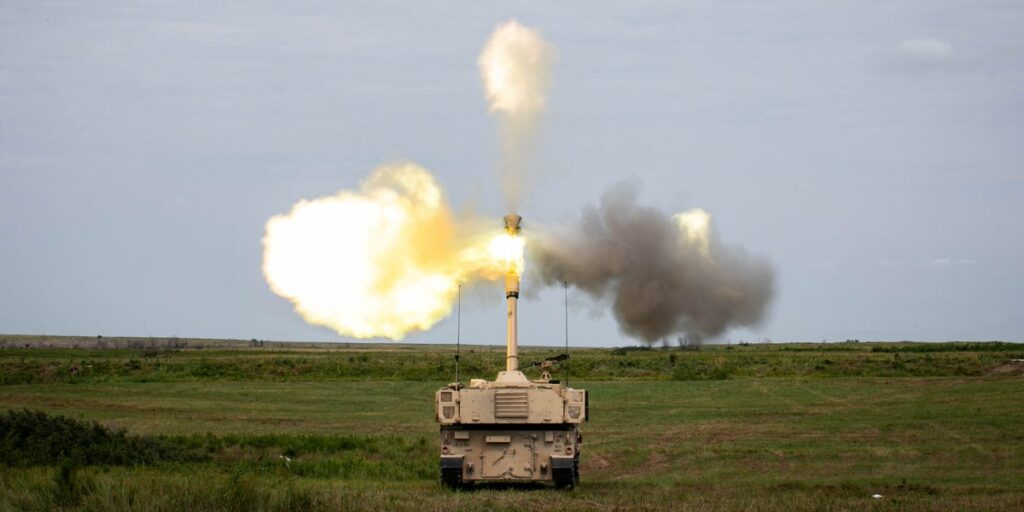- The US Army has long known that it has artillery shortcomings that need to be addressed.
- As it readies for possible future large-scale combat operations, the Army is looking to plug these gaps.
- A general told BI the Army wants new cannons that will increase the range of fire.
Satellite images of eastern Ukraine show pockmarked battlefields left scarred by relentless artillery fire. The craters are a constant reminder that these deadly cannons still play a crucial role in modern warfare.
The US Army is watching this conflict closely as it prepares for potential large-scale combat operations overseas. The importance of artillery isn’t new to it, though.
The military knows the value of being able to lob a shell or rocket down range, but it also knows it needs to step up its game. Russia and China are both stepping up theirs.
A general looking into this matter said that there are three areas where Army artillery faces serious capability gaps. He added that the hunt for artillery solutions to bridge these shortcomings is already underway.
“We saw some capability gaps against adversaries in two different theaters as we projected forward into 2030 – 2035,” Brig. Gen. Rory Crooks, director of the Army Futures Command long-range precision fires cross-functional team, told Business Insider in a recent interview.
The first deficit is range. Army artillery doesn’t have the necessary reach compared to US adversaries. “You provide enemy sanctuary, in some cases, when the enemy has a range overmatch,” Crooks explained.
Then there is capacity. The US doesn’t have enough artillery systems to match the enemy. Simply put, he said, “we’re out-gunned.”
And lastly, there are survivability concerns. Although some US rivals are divesting of their towed artillery systems, the US Army isn’t.
Typically, when soldiers fire their artillery cannons at enemy positions, they want to disperse immediately before the anticipated counter-battery fire — a tactic known as shoot-and-scoot. Towed artillery pieces like the M777 are slower and more difficult to relocate quickly compared to the self-propelled systems, which are mounted on tracked vehicles. That diminishes survivability.
“Those three problems — range, capacity, and survivability based on mobility — are really hard to overcome individually,” Crooks said, adding that “collectively, they’re very hard to overcome and put us at risk for mission success moving forward.”
In recent years, the Army has sought to extend the reach of its guns. One such effort, the Strategic Long Range Cannon, was intended to fire projectiles some 1,000 nautical miles away, but Congress halted funding for the research in 2022.
Another Army initiative, the 58-caliber Extended Range Cannon Artillery, or ERCA, began in 2018 with the aim of extending the range of artillery fire from 18 to 43 miles.
The weapon — a 30-foot gun tube mounted on the chassis of an M109 Paladin self-propelled howitzer — concluded the prototyping stage but did not end up moving into production due to problems observed during live-fire testing. The Army canceled the ERCA program last year, shifting focus to the new Self-Propelled Howitzer Modernization effort.
A Congressional Research Service report published in early February said a study of new conventional fires concluded last year found the Army should focus its efforts on “more autonomous artillery systems with greater range and improved mobility.”
It also said that even though the Army ultimately canceled the ERCA program, starting again on its hunt for artillery solutions, “a recently conducted tactical fires study validated the capability gap that the ERCA sought to fill. Observations from Ukraine reinforce the critical role of mobile cannon artillery.”
Moving forward, Crooks said that the Army is going to take the success it had with the ammunition work for ERCA and partner that with guns available on the market. He said the service is already looking into allied and partner capabilities.
The Army is specifically eyeing self-propelled howitzers with 52-caliber gun tubes. It is a middle ground between the larger 58-caliber ERCA and the smaller 39-caliber M777 towed howitzer.
“The work that we’re doing with introducing, potentially, modernized platforms that are 52-caliber in length, along with the ammunition work that we did that started with ERCA, we think we’ll be able to address the requirement that we needed from the ERCA platform and prototyping effort,” Crooks said.
Last fall, the Army announced that it had awarded contracts to five vendors for the Self-Propelled Howitzer Modernization effort. The $4 million contracts went to American Rheinmetall Vehicles, BAE BOFORS, Hanwha Defense USA, General Dynamics Land Systems, and Elbit Systems USA.
The next step is getting prototype artillery systems out to Yuma Proving Ground in Arizona, where the systems will be put through a series of firing tests. The service could make a decision on its new cannon as early as next year.
But finding a suitable and available 52-caliber gun is just one piece of the puzzle as the Army looks to overcome its range, capacity, and survivability deficits, Crooks said.
The Army also needs to continue the ammunition innovation that was started under the ERCA program, such as the XM1155 sub-caliber projectile developed for the ERCA’s 155 mm XM907E2 58-caliber cannon, and scale up its one-way attack drones so these explosive-packed weapons can be used in lieu of traditional artillery rounds.
Artillery is just one element of combined-arms warfare, but as Army leaders continue to closely watch Russia’s invasion of Ukraine, it is clear that strong cannons will be needed to achieve success in future large-scale combat operations.
“I think what we’re seeing is when you don’t have adequate artillery to achieve local fire superiority, then that battle devolves quickly to attritional warfare — static warfare,” Crooks said. And that’s not the kind of war the US military was built to fight.
Read the full article here


